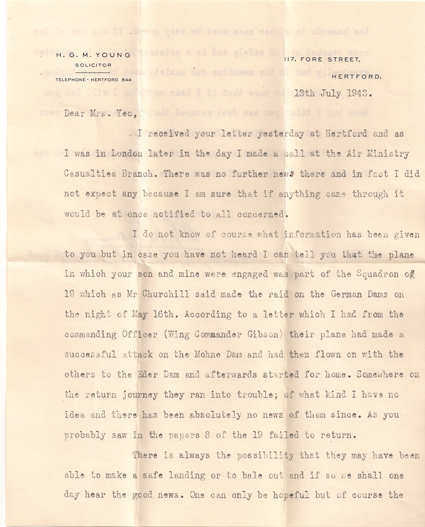
Pic: Harry Humphries collection
Sgt G A Yeo
Front gunner
Lancaster serial number: ED887/G
Call sign: AJ-A
First wave. Fourth aircraft to attack Möhne Dam. Mine dropped accurately, causing small breach. Aircraft shot down on return flight.
Born in Barry Dock, Glamorgan, on 9 July 1922, Gordon Arthur Yeo was the youngest member of Melvin Young’s crew. He was the son of Arthur and Ada Yeo and had joined the RAF in 1941, wanting to be a pilot. Having been initially posted to Elementary Flying School in Canada, he eventually qualified as a gunner.
He crewed up with David Horsfall, Charles Roberts, Lawrence Nichols and Wilfred Ibbotson at 1660 Conversion Unit at RAF Swinderby, under skipper Graham Bower. When Bower went sick, most of the crew flew on an operation to Berlin on 16 January 1943, with Plt Off Vincent Duxbury as their pilot. By the time the crew moved to 57 Squadron at Scampton in mid March, Melvin Young had taken over.
On 25 March, they were posted across the base into the fledgling 617 Squadron and the young gunner would have met a few with much more experience than him. But he would also have found several more, like him, with very few operations under their belts.
Yeo wrote several letters to his parents during his time on 617 Squadron, and they give us some insight into how hard they trained, and what they did in their spare time. Melvin drove the crew into Lincoln on a day off from training to watch a parade which was part of the city’s ‘Wings for Victory’ week. This reminded the crew of their skipper’s chequered history.‘We had a good laugh at the blokes all dressed up in flying clothes and sitting in the dinghy. [Melvin Young] had a good laugh at them because he had detailed them.’ Later, he told his parents about Young’s determined efforts to ensure they were trained hard: ‘You say you want to know the name of our skipper, well here it is, S/Ldr H M Young, he is not so bad lately, I expect that is because we are getting used to him, but he is the cause more or less of us not getting leave.’
The Lancaster’s front gun turret was not used during most war time operations, but on the Dams Raid it was manned as the modification for the special mine had necessitated the removal of the mid upper turret. So Yeo would have used it to fire directly ahead of him at the Möhne’s gun emplacements as Young kept the aircraft steady in its bombing run.
AJ-A was shot down at the last moment of danger shortly after they had passed over the Dutch coast. Gordon Yeo’s body was washed ashore on 27 May 1943, along with those of Lawrence Nichols and Vincent MacCausland. They were all buried in Bergen General Cemetery.
In the months after the raid, Gordon Yeo’s mother must have written to Henry Young, Melvin Young’s father, as his reply to her dated 13 July 1943 shows. He ends his letter with the sad words: ‘With many thanks for your kind sympathy which I feel too for all those who have suffered the same loss.’


Two families, united in grief. Almost 1400 more people lost their lives that night, and their families would also be suffering in the same way.
More about Yeo online:
Commonwealth War Graves Commission
KIA 17 May 1943.
Rank and decorations as of 16 May 1943.
Sources: Arthur Thorning, The Dambuster who Cracked the Dam, Pen and Sword 2008
Richard Morris, Guy Gibson, Penguin 1995
John Sweetman, The Dambusters Raid, Cassel 2002
 Further information about Gordon Yeo and the other 132 men who flew on the Dams Raid can be found in my book The Complete Dambusters, published by History Press in 2018.
Further information about Gordon Yeo and the other 132 men who flew on the Dams Raid can be found in my book The Complete Dambusters, published by History Press in 2018.













 Further information about Gordon Yeo and the other 132 men who flew on the Dams Raid can be found in my book
Further information about Gordon Yeo and the other 132 men who flew on the Dams Raid can be found in my book